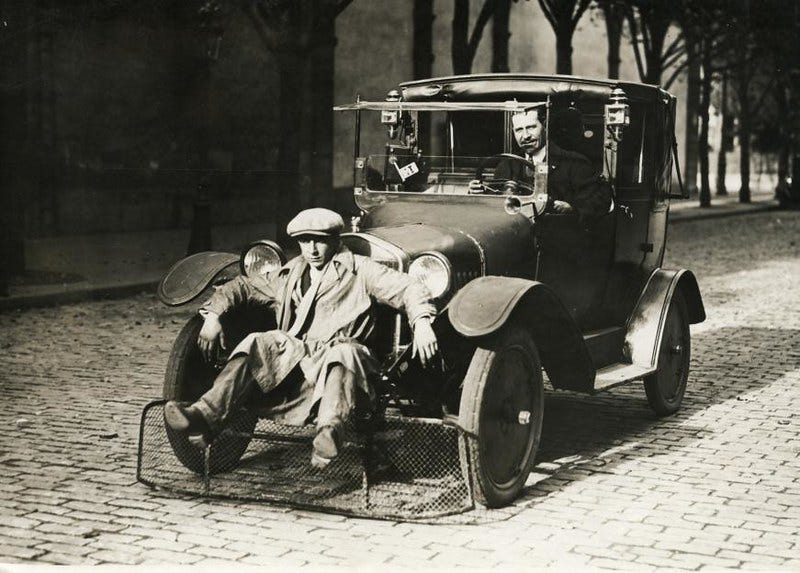Editor's note: a version of this article originally appeared on Urbanism Speakeasy. It is republished with permission.
The Governors Highway Safety Association is crunching numbers on pedestrian fatalities, and they expect the final tally to be 7,508 people killed while walking in 2022. That’s the most since 1981. In their words:

Between 2020 and 2021, pedestrian deaths increased 16%, while other traffic fatalities increased 10 percent. More alarmingly, since 2010, pedestrian deaths have gone up a shocking 77 percent, compared to a 25 percent increase in all other traffic fatalities.
To help understand these statistics, let's compare the word in American and Danish laws when it comes to how the lives of a pedestrians are treated.
The Danish Mindset: “We’ll slow down in case you need to cross.”
Long ago, the Danes adopted a proactive and protective approach toward pedestrians. Here's an excerpt Danish Traffic Act § 27:
Drivers who approach a pedestrian crossing that is not regulated must adjust their speed in such a way that there is no danger or inconvenience to pedestrians who are in the crossing or are on their way into it. If necessary, the driver must stop to let pedestrians pass.
The motorist is responsible for not endangering or inconveniencing pedestrians, even before those pedestrians reach a designated crosswalk. This is a pragmatic application of the “streets are for people” slogan: giving vehicular traffic the back seat.
Here’s the part that's so un-American about the Danish Traffic Act: motorists are required to adjust their speed in such a way that there is no inconvenience to pedestrians who are are on their way into the street.
No inconvenience. Can you imagine?! Maybe a person steps off the curb, maybe they don’t. Maybe the stroller dips into the crosswalk, maybe it doesn’t. The point is that whenever there’s a potential conflict, pedestrians are given the priority.
The American Mindset: “We’ll hit the brakes when your foot hits the street.”
In the U.S., by contrast, motorists are typically given the right-of-way until a pedestrian begins crossing — a.k.a., until the baby stroller is already in harm's way. That’s because American transportation professionals have fooled themselves into thinking travel modes can be balanced.
Let's be clear: there is no such thing as multimodal balance. Someone always gets top priority, and in the US, the legal framework reinforces the perverse incentives of motordom. (See Fighting Traffic by Peter Norton.)

American laws put a significant burden on those walking, rather than on drivers. Our traffic laws tend to prioritize the movement of vehicles, lest a motorist be forced to give vulnerable road users a hint of convenience and safety. These laws reflect the car-centric mindset that has become a cultural norm.
It’s bad enough that pedestrians are gambling with their lives at a crosswalk, guessing about the intentions and awareness of drivers. But it’s even worse at mid-block. Especially on deadly roads like four, six, or even eight lane arterials, it's often actually more convenient to cross in between intersections, rather than walking an extra quarter or half mile to get to the other side.

Here are a few examples of the subtle legal language that puts the burden on the most-likely-to-die road users.
New York
New York State Vehicle and Traffic Law Section 1151:
When traffic-control signals are not in place or not in operation, the driver of a vehicle shall yield the right of way, slowing down or stopping if need be to so yield, to a pedestrian crossing the roadway within a crosswalk on the roadway upon which the vehicle is traveling, except that any pedestrian crossing a roadway at a point where a pedestrian tunnel or overpass has been provided shall yield the right of way to vehicles.
California
California Vehicle Code Section 21950:
The driver of a vehicle shall yield the right-of-way to a pedestrian crossing the roadway within any marked crosswalk or within any unmarked crosswalk at an intersection.
Massachusetts
Massachusetts General Laws Chapter 89 Section 11:
When traffic control signals are not in place or not in operation the driver of a vehicle shall yield the right-of-way, slowing down or stopping if need be to so yield, to a pedestrian crossing the roadway within a crosswalk marked in accordance with standards established by the department of highways if the pedestrian is on that half of the traveled part of the way on which the vehicle is traveling or if the pedestrian approaches from the opposite half of the traveled part of the way to within 10 feet of that half of the traveled part of the way on which said vehicle is traveling.

Try describing the American vs. Danish approach to a child. Break it down in plain language, and see how they react. They’ll probably want to seek shelter inside a vehicle forever and always.
If you’re talking with adults about motorist vs. pedestrian right-of-way, add in the issue of stopping distance. If a driver waits until a person has stepped into the street before slowing down, the chances are much higher of a crash. Either experts believe the laws of physics don’t apply to American drivers, or that pedestrians aren’t important enough to be protected.
Andy Boenau is an author, filmmaker, podcaster, and writer of the Urbanism Speakeasy Substack. Find him @Boenau on Twitter and LinkedIn.






